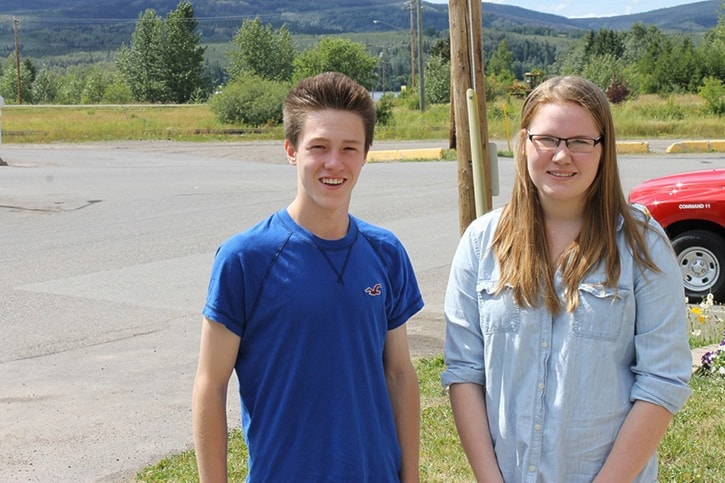Two Lakes District Secondary School (LDSS) students have returned from their 10 day trip to Beijing, China, as part of an educational summer camp hosted by the Beijing International Education Exchange.
Emma Conlon and Ryan Skinner, both who will be entering Grade 11 this September at LDSS travelled to Beijing on July 11 for the week long camp, July 13-21, where they learned about Chinese culture and history.
Both Conlon and Skinner were joined by other students from the Nechako Lakes school district and other high school students from across Canada.
In total there were more than 800 students and teachers from 24 different countries, including Spain, Finland, Australia and Kazakhstan that attended the week long camp this year.
For Conlon and Skinner their introduction to Chinese culture started from the moment they stepped off of the airplane in the airport in Beijing.
"When you step off the airport in Beijing you experience the cultural difference right away, there is Chinese art everywhere and the second you step off the plane to get a huge gust of hot air in your face," Skinner said.
"Stepping of the airplane it was pretty surreal. It doesn't set in that you're somewhere completely different and on another continent. It probably didn't set in for a couple hours. Plus there are so many more people there, I think Beijing has 23 million people living in the city," Conlon said.
Conlon applied and was accepted for the trip by late April, early May.
She made a powerpoint presentation about why she wanted to go that was reviewed by representatives from the school district.
Skinner originally wasn't attending the camp, but there was a last minute dropout from another school in the province and he was selected to go a little under month before the group departed from Vancouver.
Both Conlon and Skinner found the camp to be a really enjoyable experience, noting that there was a really friendly atmosphere amongst everyone attending.
And while the airport experience was the first bit of Chinese culture both experienced, the camp was where both were absorbed into the culture.
"We met many people from different countries and you experience so much Chinese culture because there are Chinese students there with you," Conlon said, "We got to visit one of their other high schools the third day we were there. So it was just really cool to get to experience their culture when it comes to education. The high school in Beijing was really big, their outdoor gym area is the size of our gym and their classroom sizes are smaller than ours."
One of the major differences in education in Chinese culture compared to Canadian culture that both noticed was the sheer amount of schooling that Chinese students go through.
"They're there at school from around 6 a.m. to 7 p.m.," Conlon said.
"The majority of their day is spent in the classroom and at school," Skinner said "Another thing I noticed was that they are always tired because they stay up until 1-2 a.m. studying and then they have to wake up before 6 a.m. again to start their school day over, and they sometimes have school on Saturdays, so they are always sleeping. They slept a lot on the bus."
While Chinese students had classes similar to those offered in Canada, such as auto shop, wood shop and drafting and design classes, both noticed that there were many more specialized classes that students could take that would help them in their planned career of choice.
The camp wasn't as strictly run as traditional Chinese school, but was still packed with activities each day.
The students had from 7-8 a.m. each morning to eat breakfast, and were in classrooms by 8:30 a.m. where they focused on learning about different aspects of Chinese culture, including Chinese calligraphy, Kung Fu lessons and about the history behind different Chinese celebrations, such as those for Chinese New Year.
Lunch was held at 11:30 a.m. and the afternoon was spent touring historic spots in and outside the city.
Conlon and Skinner got to walk on the Great Wall and were taken to the Forbidden City, although unfortunately the famous Terracotta Warriors weren't there for the group to see.
Both Conlon and Skinner wish that the camp would've been an additional week solely because they just didn't get to meet as many people as they would've liked.
"You really didn't get to know many of the people that well just because there is so many of them," Conlon said, "I maybe met half, maybe. And still that is meeting 400 people so I mean that's a lot of people to meet in 10 days."
"I met probably 100 people and talked to a bunch of others just saying hi," Skinner said.
They both spent each day with the same group of students, Conlon with students from Spain and Kazakhstan and Skinner with students from Australia.
If they ever get the opportunity to go back to the camp each would make an even greater effort to reach out to students from more countries.
"I would apply and go back again absolutely," Skinner said, "If I had to do it over again I'd meet more people from other places and I'd try to learn the language a little better even before I went."
Conlon said there just wasn't enough time to meet everyone, but adds she'd go back in a heartbeat.
"I'd definitely go back to China in a heartbeat, especially with that program," Conlon said.
